Common Name(s): European yew, common yew, English yew
Scientific Name: Taxus baccata
Distribution: Europe, Southwest Asia
Tree Size: 30-65 ft (10-20 m) tall,
3-5 ft (1-1.5 m) trunk diameter
Average Dried Weight: 42.1 lbs/ft3 (675 kg/m3)
Specific Gravity (Basic, 12% MC): 0.55, 0.67
Janka Hardness: 1,520 lbf (6,760 N)
Modulus of Rupture: 14,030 lbf/in2 (96.8 MPa)
Elastic Modulus: 1,472,000 lbf/in2 (10.15 GPa)
Crushing Strength: 8,410 lbf/in2 (58.0 MPa)
Shrinkage: Radial: 3.4%, Tangential: 5.3%,
Volumetric: 8.3%, T/R Ratio: 1.6
Color/Appearance: Sapwood is usually a thin band of pale yellow or tan color, while the heartwood is an orangish brown, sometimes with a darker brown or purplish hue. Color tends to darken with age.
Grain/Texture: Grain is straight, with a fine uniform texture. Good natural luster.
Rot Resistance: European yew ranges from durable to very durable in regard to decay resistance, and is also resistant to most insect attack.
Workability: Overall, an easy wood to work, though knots and other grain irregularities can pose a challenge. Yew glues, finishes, and turns well.
Odor: No characteristic odor.
Allergies/Toxicity: Although severe reactions are quite uncommon, yew has been reported as a irritant. Usually most common reactions simply include eye, skin, and respiratory irritation, as well as nausea, headache, and cardiac effects. Additionally, nearly all parts of the yew tree are considered toxic and poisonous to humans, and care should be exercised when working with this wood species. See the articles Wood Allergies and Toxicity and Wood Dust Safety for more information.
Pricing/Availability: Yew is relatively uncommon, and larger tree trunks are usually hollow. Selection and sizes are somewhat limited, especially since most trunks are also full of knots, resulting in a high waste factor for many projects. Though sections of wood can sometimes be obtained for moderate prices, the overall cost of usable wood tends to be high.
Sustainability: This wood species is not listed in the CITES Appendices, and is reported by the IUCN as being a species of least concern.
Common Uses: Bows (archery), veneer, cabinetry, furniture, carvings, musical instruments (lutes), and turned objects.
Comments: Perhaps among the hardest of all softwood species, yew is certainly a unique wood species. Its density and working characteristics are more inline with a heavy hardwood than a softwood, yet its tight, fine grain and smooth texture give it a lustrous finish.
Yet perhaps yew’s greatest claim to fame is that of its mechanical properties: the wood is flexible, yet strong, making it ideally suited for use in archery bows (yew was the wood of choice for English longbows in medieval warfare). This uniqueness in mechanical properties has been shown to arise primarily from its high microfibril angle (MFA). See the article on Bow Woods for a more in-depth explanation of MFA.
Images: Drag the slider up/down to toggle between raw and finished wood.
A special thanks to Steve Earis for providing a wood sample and the turned photo of this wood species.
Identification: See the article on Softwood Anatomy for definitions of endgrain features.
Resin canals : absent
Tracheid diameter : very small
Earlywood to latewood transition : gradual
Grain contrast : medium
Parenchyma : none
Lookalikes/Substitutes: With its relatively high density and hardness, yew is more likely to be confused with fine-textured diffuse porous hardwoods, such as common boxwood (Buxus sempervirens), rather than other softwoods. The poreless nature of softwoods will quickly separate them from all hardwoods, though magnification may sometimes be necessary to clearly see the small pores in some hardwoods.
Notes: None.
Related Content:

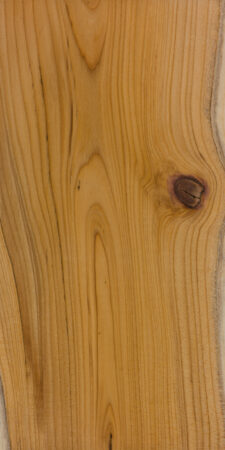
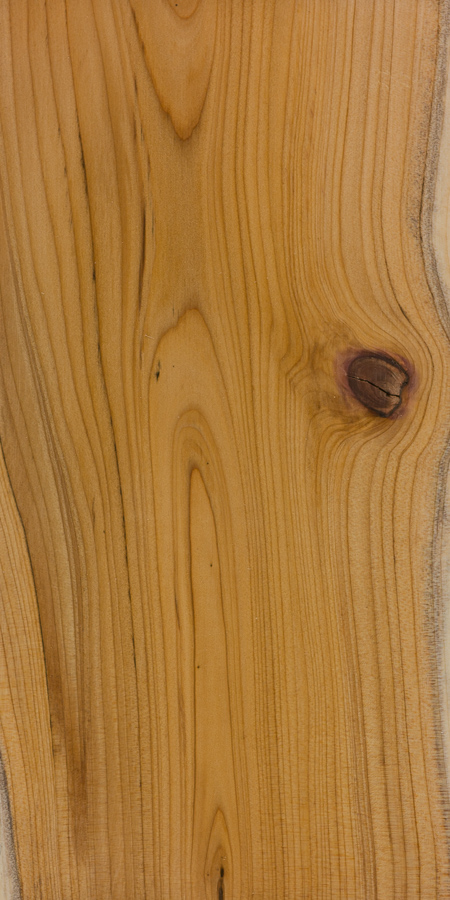
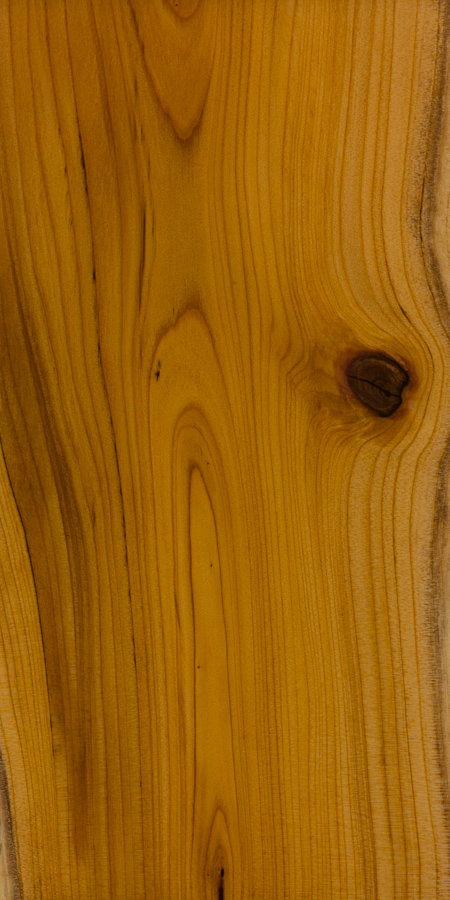
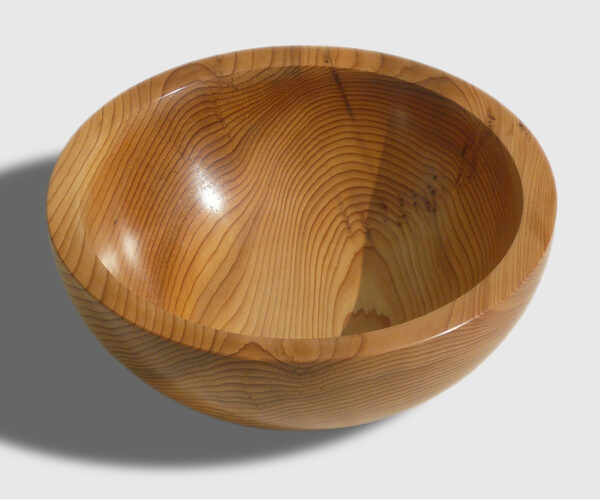
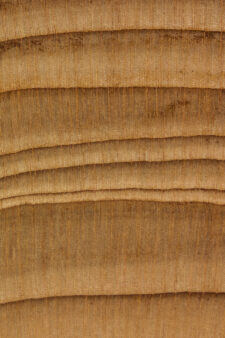



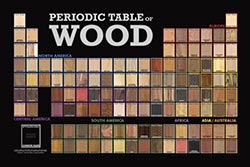

The worlds oldest wooden artifact, the Clacton Spear, is made of this species and is 420,000 years old! That pre-dates our species, by the way.
https://en.wikipedia.org/wiki/Clacton_Spear
Not the English. Otzi the mumified man found in the alps (3.300 BC) carried a six foot longbow made of Yew as did Egyptians Vikings and uncle Tom cobley and all.
Awesome figure, color and workability…
If only I could find a piece large enough to make a billet out of. This thing makes awesome bows. Very easy to use. I broke a bow one time and reused the pieces to make a hammer handle. It STILL hasn’t broke and feels great on the hands
Hi, I have been offered some off cuts of yew from a friends wood store to use for a project the only thing is a fox has been in the store along with many rats over the years. What’s the best thing to clean the pieces of wood with before I start using them? can you please advise
Paul Sellers, English woodworker, blogger, teacher, youtube guy has a video series making plane handle and knob from yew without a lathe. Beautiful but of course he’s extremely skilled. https://paulsellers.com/2020/08/plane-knob-without-a-lathe/
Hi,
I have a hand-carved crochet hook, made of yew by a friend in Germany, about 10 years ago. I wash my hands after using it, and she warned me about keeping it away from pets (why do cats attack wooden needles and hooks? I bet there’s a PhD in there for the right person). I think the finish was very fine sanding, no oil. Some bark was left on the handle end. But now I wonder if it’s still as poisonous as it was. Any ideas?
Apparently according to some other comments iv read, thought not sure how much of it is true or not. The toxins in the wood never subside so they are in there for life and the furniture should be considered carefully as the use of bowls for sitting foods in isn’t recommended because the toxins can seep out over time. Also the dust is very poisonous is airborne so should take care when working with it.
I work with yew every day and have never had a problem. It seems a bit exaggerated when it comes to its toxicity, in my honest opinion.
I believe the risk is small. You can treat the crochet hook with boiled linseed oil to lock any toxins in the wood. You can then finish with paste wax to make the hook both slick and waterproof. This should prevent any dermal transfer of toxins.
Hi. I only use boiled linseed oil on yew for the sealing and to prevent cracking down the grain boundary lines as old European Yew likes to do. If it’s a young tree then the cracking during drying or natural drying does not happen as much. I made a lovely bushcraft knife with yew handles and with yellow liners and the grain is all twisted and contorted with knots and eyes all over them with purple and red streaks running through the handle and it’s the darkest yew I’ve ever seen and the most beautiful I’ve ever seen. I lost… Read more »
I prefer “raw linseed oil” as there are as it is not treated in any way or have any additives, so is food safe. It is taken as a dietary supplement.
https://en.wikipedia.org/wiki/Linseed_oil
I have a pile of yew from a churchyard tree that fell down. There is quite a story to this but my main task now is to make a number of ‘billets’ or slats which will form a bench. Each slat will be about 75mm x 30mm in section and varying from 200mm to 600mm long. Any comments re treatment, as the bench will be outside in a churchyard, would be very helpful.
I would cut veneers rather than use as thick boards and think of another way to honor the tree and maximize the amazing grain graphics they offer to us!
Hi my Name is Stu and I live in the U.K.. yew is very well known in this country in fact it’s been used for over a thousand years here. How ever it is very toxic and indeed every part of the Yew Tree is Toxic and is laced in heavy metals like lead and arsenic and poisonous alkaloids. If you ever turn a bowl out of this wood never ever put fruit or any food in the bowl you intend to consume. It’s well known in this country (UK) because our bowyers used to use it to make our… Read more »
I have bought a Yew Stave.
To make a bow.
Any advise as to safety precautions?
Roy Haworth.
I have been turning yew for 24 years and have not died or been sickened. It is likely that the lifespan of archers is short because they are pierced by arrows. The wood must be sealed thoroughly and not used for cutting on or for storage. That being said, I usually just turn a hollow form or a vase.
I agree, I’ve never had ill effects or anything and I turn yew wood almost daily.
It’s the seed and the foliage that kill bears. The fleshy part of the berry is safe but it would be a very unwise choice for eating. I’m not convinced that the timber is toxic, but most woods cause some reaction in a some people. Don’t eat it. People use it for salad bowls, but a chopping board (say) might be better in another wood.
Note that toxicity varies greatly between yew species. Pacific (t.brevifolia) is far less toxic than others. I would assume for safety sake that it could vary greatly from one tree to the next. The most toxic is the asian, which is found in landscaping use from nursery plants throughout North America. European is also planted widely through North America and is nearly as toxic as asian. Which is it? Do they interbreed? So I would always assume I am dealing with a highly toxic variety unless I had good reason to think otherwise. How toxic? Every year there are articles… Read more »
Makes a stunning knife handle, keep it oiled as it chips if dropped, always catches the eye when bushcrafting, when worked to create the long bow it was backed with Ash fraxinus exelsior. Yew is a brilliant firewood if properly seasoned. I am a tree surgeon folklore says its bad luck to cut yew, i find this to be true to anyone cutting the trees, learn the timber characteristics and avoid blunt tools, it has a habit of causing saws to jump out of the cut probably due to density and the thin wire like twigs that send chains out… Read more »
I found European Yew EXTREMELY hard to turn for my purposes, which was making drumsticks for hand drums. The wood is quite hard but so flexible that the lathe tool is always being brought under it, or rather the piece rides up and over the tool. A stabilizer might help prevent this
I recently tried to turn some drumsticks out of European Yew and found it really hard to work with. It’s hard wood; it has knots, but the worst part is the flexibility. It wants to flex up and over your tool. I was turning thin spindles, about 3/8 of an inch or so, and as soon as I’d get below about 3/4 it would start pulling the tool under, or rather bending over the tool head I tried a conventional roughing gouge and a very sharp carbide “easy tools” rougher, and while the easy tools rougher was better, it was… Read more »
No don’t worry about the poison. I cut them often with hand and chain saws. Get covered in sawdust from head to toe and don’t experience any problem with fresh of dried Yew wood.
Here in the South of England this is a fairly common tree and the timber is available but is rarely kiln dried
I don’t take measures when working with it. Never used gloves or respirator but if green i always wash my hands after working with it. I only found that by the time i was working it i went to the WC A LOT of times!! O_o’ since then i use allways respirator when sanding or everytime there’s yew dust in the air. I’m still alive, fine, and happy with my yew bow and the kayak beams i did with it. Here in spain the yew is a very protected tree. Even if it is in your garden you have to… Read more »
Good info, thanks. What is meant by “I went to the WC a lot”? This “WC” abbreviation is not one that I am familiar with…
Hehe i’m talking about the Water Closet or commune. I started using the respirator when sanding because i readed that one of the effects of being poisoned is heavy stomach ache and diarrhea. Mine was not painful at all but i felt it was not normal to go to the W.C. that oftenly…
Be careful !! This wood is deathly poisonous ;)
Taxus is a rare tree, it also grows solitary, so they’re difficult to find. In Italy we have some very old trees whose position is not marked in the national park’s maps, and you have to request a guide to see them. They’re large and impressive, with that big, hollow trunks, like those seen in horror movies, but I don’t know if they’re a protected specimen at all, even the young trees.
They may be rare if you are talking about old-growth trees in woodland, but they’re a common garden hedge species.
The comments neglect an important mechanical property that made yew the wood of choice for longbows: The heartwood is highly resistant to compression, and the sapwood is highly resistant to tension. This meant that a bow carved along the heartwood / sapwood boundary had all the advantages of a composite wood bow (higher draw to weight ratio and livelier release) and none of the disadvantages (such as a tendency to loose strength and fall apart on hot, humid days).
The Yew I work with is from Vancouver Island, Canada. It is very workable and easy to control. The tight grain gives nice color variations and patterns. A mountain side was clear cut, with all commercial wood being removed, but the Yew was left to rot, a shame. I love working with it, making canes and staffs, but I am concerned with the toxicity rating. Can anyone tell me if holding a cane made of Yew would be dangerous to the user?
I can tell you from using a yew walking stick for over thirty years that I have had no health problems caused by the stick. ( unlike the 6 skin heads that had a go at me in a subway they found it to be very bad for tooth decay) this has been my companion since my spinal injury in the armed forces and I would recommend a yew walking stick to anyone in need it is strong light and flexible.